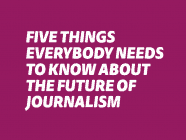
No matter whether you are a staff journalist or sailing freelance, you will know this: A good story pitch is a craft of its own.
At the same time, it can feel like a shot in the dark — especially when you have not established a personal connection to your newsroom of choice yet.
But is there a recipe for a perfect pitch? To answer this question, we decided to ask those in charge: editors at some of the biggest media outlets in Europe, awarded with our European Publishers Reporting Grants.
At our Journalism Grants Bootcamp training days for grantees, they shared with us the small and big details that make the difference between an average and an outstanding story pitch.
Here are three golden rules from editors to make your story stand out:
1. Do Your Homework
Understanding the publication that you’re pitching to is key. A quick research goes a long way: browse through the topics and genres your outlet of choice has already published.
If their mission and audience aligns with your story, chances are high that you can show how your piece will drive the matter forward.
Make sure you send your pitch to the right editor dealing with the topic you are covering. This way, you can be sure your pitch reaches the person most interested in your story.
This advice, however, comes with a note of caution: If you find that not only your topic, but your story has already been covered, it might be a sign that your idea is not new and you should rework it.
2. Know What To Tell — And What To Keep
One of the first questions editors have about a story is: Why would the reader care? Find a compelling answer and give them the tools to make a case internally to select your story. This also shows that you understand the publication.
It’s crucial that you are transparent about your story’s funding. Provide how much money you need to cover the costs — and, equally important, which costs you have already covered.
List your sources like fundings, grants and other non-competitive media partners. In case you are planning a data-driven story, provide how the data was found.
While transparency is key, make sure to balance how much information you give. It’s an ugly truth, but sometimes stories get stolen. Protect yourself and don’t write down all your newest and valuable findings in the first pitch.
3. The Medium Is The Message
Your story fits the publication and you have all the information you want to include. Now make sure that the same goes for the package. Does your media publish in the format you’re trying to pitch them?
When you are suggesting details, think within the formats, structures and language of your publication of choice. To make your story fit, you need to be open to adapt it accordingly.
Editors are busy people and will only have a very limited attention span to read your pitch. Grab their attention from the get-go with a well thought through logline that delivers your key message and tells them how your story might look like.
Want more advice? Here are some quick bonus tips by our publisher partners:
- Add a compelling headline to win over the editor’s heart. It’s one of the key components to advance your pitch.
- If you plan to include visual elements like photos, illustrations or video in your stories, make sure to send an example to show that you know what a good quality picture looks like.
- Include your short resume to make a case you are the right journalist with the experience to deliver this story.
- Editors don’t like reactionary stories. If you want to discuss an issue, do it through original reporting — not by calling out someone else.
- Nothing beats a good story, so don’t only rely on promising the use of innovative technologies.
- Don’t fear rejection! Most of the times, the first pitch will not be accepted — but it’s the start of your relationship with the editor, which might be more useful later down the line.
- That’s why in case you are rejected despite all your efforts, always ask for feedback so you know better next time.
Opinions expressed on this website are those of the authors alone and do not necessarily reflect or represent the views, policies or positions of the EJO.
If you liked this story you might also be interested in Ten Tips for Writing Reliable and Engaging Health Articles
Tags: Freelance Journalism, Freelance writing, freelancers, Journalism, journalism advice, media, pitch, pitching, writing













































